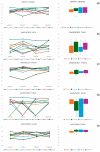Evaluation of Cannabidiol Oil's Effects on Sedation, Behavioral Responses to Handling, and Nociceptive Thresholds in Healthy Cats
- PMID: 40646886
- PMCID: PMC12248893
- DOI: 10.3390/ani15131987
Evaluation of Cannabidiol Oil's Effects on Sedation, Behavioral Responses to Handling, and Nociceptive Thresholds in Healthy Cats
Abstract
This study explored the effects of cannabidiol (CBD) on clinically relevant parameters, including sedation, compliance, and temperament, as well as mechanical nociceptive thresholds in healthy cats. Nine client-owned cats (3.44 ± 2.35 years, mean ± standard deviation) were assessed prior to (baseline) and 30 min, 1, 2, 4, 8, 12, and 24 h after oral administration of 8 mg/kg CBD oil via capsule. Sedation scores increased significantly 2, 4, and 8 h post administration compared to baseline (all medians = 1 vs. 0 at baseline; p < 0.001). Compliance and temperament scores were significantly reduced 2 and 4 h post dosing, with median scores decreasing from 1 at baseline to 0 after 2 and 4 h for both parameters (p < 0.001 and p = 0.012, respectively). Mechanical nociceptive thresholds and sensitivity, assessed using an algometer and von Frey filaments, respectively, along with physiological parameters (heart rate, respiratory rate, and body temperature), remained unchanged across timepoints. These results indicate that 8 mg/kg CBD induces mild sedation and reduces handling resistance in healthy cats without affecting nociceptive thresholds or physiological stability. Therefore, CBD may facilitate non-painful procedures requiring animal cooperation; further controlled studies are warranted to confirm these findings.
Keywords: behavior; cannabidiol; cat; compliance; nociceptive threshold; sedation.
Conflict of interest statement
The authors declare no conflicts of interest. The funders and CBD oil provider company had no role in the design of the study; in the collection, analyses, or interpretation of data; in the writing of the manuscript; or in the decision to publish the results.
Figures







Similar articles
-
The Black Book of Psychotropic Dosing and Monitoring.Psychopharmacol Bull. 2024 Jul 8;54(3):8-59. Psychopharmacol Bull. 2024. PMID: 38993656 Free PMC article. Review.
-
Sertindole for schizophrenia.Cochrane Database Syst Rev. 2005 Jul 20;2005(3):CD001715. doi: 10.1002/14651858.CD001715.pub2. Cochrane Database Syst Rev. 2005. PMID: 16034864 Free PMC article.
-
Drugs for preventing postoperative nausea and vomiting in adults after general anaesthesia: a network meta-analysis.Cochrane Database Syst Rev. 2020 Oct 19;10(10):CD012859. doi: 10.1002/14651858.CD012859.pub2. Cochrane Database Syst Rev. 2020. PMID: 33075160 Free PMC article.
-
Etanercept and efalizumab for the treatment of psoriasis: a systematic review.Health Technol Assess. 2006 Nov;10(46):1-233, i-iv. doi: 10.3310/hta10460. Health Technol Assess. 2006. PMID: 17083854
-
Corticosteroids for the treatment of Duchenne muscular dystrophy.Cochrane Database Syst Rev. 2016 May 5;2016(5):CD003725. doi: 10.1002/14651858.CD003725.pub4. Cochrane Database Syst Rev. 2016. PMID: 27149418 Free PMC article.
References
-
- Kogan L.R., Hellyer P.W., Robinson N.G. Consumers’ perceptions of hemp products for animals. J. Am. Holist. Vet. Med. Assoc. 2017;42:40–48.
Grants and funding
LinkOut - more resources
Full Text Sources
Miscellaneous

